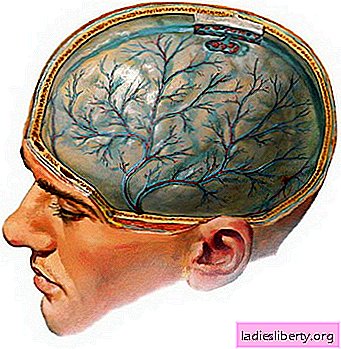
Meningitis - A disease associated with inflammation of the membranes of the brain and spinal cord. The source of the disease are viruses, bacteria and other microorganisms.
Medicine distinguishes leptomeningitis - inflammation of the arachnoid and soft membranes of the brain and pachymeningitis - inflammation of the dura mater. The disease occurs and develops as an independent or is a consequence of the inflammatory process caused by another disease.
Meningitis - Causes
In the vast majority of cases, 3 types of bacteria cause meningitis: meningococcus, hemophilic bacillus and pneumococcus. These bacteria can be present in the upper respiratory tract of a healthy person and do not cause any negative consequences. But sometimes microorganisms infect the brain for no apparent reason.
Sometimes meningitis occurs due to trauma or a general weakening of the human immune system as a result of the transfer of various diseases. Quite often, people who abuse alcohol, have undergone spleen removal or pneumococcal infection, as well as having various inflammatory diseases of the nose and ear, get sick.
In rare cases, E. coli or Klebsiella can cause meningitis. Diseases caused by these bacteria usually develop after injuries to the spinal cord or brain, and also as a result of blood poisoning.
Meningitis - Symptoms
Meningitis most often begins acutely. The manifestation of the disease is preceded by a fever, muscle pain, weakness, as well as the characteristic signs characteristic of a particular pathogen: with pneumococcus - a runny nose and pneumonia, with meningococcus - a rash, with enterovirus infection - an intestinal disorder, with mumps - a violation of the salivary glands.
Headache is one of the most striking symptoms of meningitis. As a rule, the pain quickly increases and reaches such a level of intensity that children begin to scream or cry, and adults groan. After a while, nausea begins, reaching up to vomiting, sometimes repeated. With a change in body position, with visual or sound stimuli, the pain intensifies.
A day after the onset of the first symptoms of meningitis, the condition worsens sharply, confusion, irritability, drowsiness appear, which can go into a stupor or into a coma. The disease leads to swelling of the brain tissue, inhibit blood flow, causing symptoms similar to those of a stroke. Lethal outcome is possible.
Meningitis - Diagnosis
For the diagnosis of meningitis, a general blood test and spinal puncture are used. The causative agent of the disease is determined by the characteristic signs of spinal puncture.
Meningitis - treatment and prevention
Meningitis is only treated in a hospital setting.
First of all, urgent medical attention is needed, since bacterial meningitis can cause death within a few hours. In the treatment of the disease, drugs are used that improve cerebral blood flow, antihypoxants, antioxidants, nootropics (nootropil, piracetam, cinnarizine). Unfortunately, even if treatment is started immediately, bacterial meningitis is fatal in 10% of cases.
After the termination of inpatient therapy, the condition of patients is monitored by a neuropathologist. Excessive physical and psycho-emotional stress, prolonged exposure to direct sunlight are contraindicated for those on the mend. In addition, increased use of salt and liquid is excluded, alcohol at any dosage is contraindicated.
As a prophylaxis of meningitis, vaccination against a specific pathogen is used.











